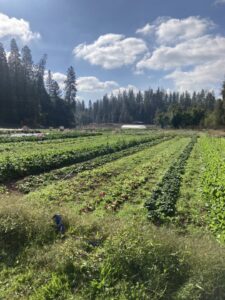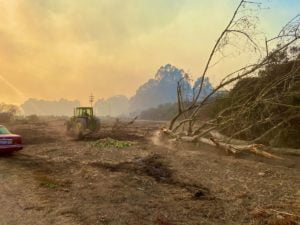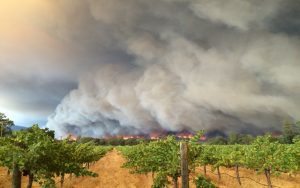
Webinar: Small Farms Disaster Insurance Part 1
From Farmer Campus, this webinar provides an overview of insurance for small farms, including how insurance works and what to buy.
In the aftermath of a disaster, it might seem like there’s no hope. But in fact, a number of resources exist for survivors as well as affected farms and communities. From financial aid to techniques that help restore your land after a fire, we’ve compiled these resources to help get you back on your feet.
Whether you lost your home, property, crops, livestock forage or a job, there are many options that might help you recoup your losses.


From Farmer Campus, this webinar provides an overview of insurance for small farms, including how insurance works and what to buy.

In this two part photo blog series, Farmer Campus talked with farm manager David Cooper to hear his wildfire story and get a glimpse into the realities of farming with wildfire and how to recover.

In this two part photo blog series, Farmer Campus talked with farm manager David Cooper to hear his wildfire story and get a glimpse into the realities of farming with wildfire and how to recover.

The U.S. Department of Agriculture has multiple agencies that provide financial and/or technical assistance to help farmers, ranchers and rural landowners recover from natural disasters, such as wildfires. Listed are USDA agencies and an overview of applicable programs. Funding for

A quick summary of all of FSA (Farm Service Agency) disaster programs and a guide that shows what type of disasters they cover.

Learn about USDA disaster assistance programs that might be right for you by completing five simple steps.

If you are a property owner and your property is located in an area designated as a disaster by the President of the United States or the Governor, and you cannot locate the insurance policy for the property and are

SBA provides low-interest disaster loans to businesses of all sizes, private non-profit organizations, homeowners, and renters. SBA disaster loans can be used to repair or replace the following items damaged or destroyed in a declared disaster: real estate, personal property,

Disasters can wreak havoc on your land. How you manage your land in the weeks and months following a disaster will determine well those natural resources recover.


INTRODUCCIÓN La Ley de Modernización de Inocuidad de los Alimentos fue promulgada en 2011 y comprende numerosas normas. Una de ellas es la Norma de Seguridad de los Productos Agrícolas Frescos (PSR, por sus siglas en inglés), que fue creada

Introduction In 2011 the Food Safety Modernization Act was signed into law. Of the many rules in this law, the Produce Safety Rule (PSR) was created to address federal food safety requirements at the farm level, specifically for produce crops.

Gullies pose many threats to farmland, including the removal of fertile topsoil, damage to infrastructure, danger to livestock, and decreased water quality. Also, due to loss of protective vegetation, erosion can increase after wildfire. Gully stuffing can reduce water velocity,

The symposium brought together researchers who have been investigating the impacts of the Camp Fire and other urban fires in Northern California. Speakers covered a diversity of research conducted on waterways, gardens, working landscapes and the urban environment following the

CAFF’s Wildfire Resilience Program collaborated with the National Farmers Union to create a unique resource called “What to Know About Wildfire & Food Safety”. Be sure to peruse the links below and learn more about how wildfires can impact soil

From CoRenewal, this webinar features Taylor Bright and Matthew Trumm, who will explain the how, what and why of proposed bioremediation approaches, and lessons learned during post-fire wattle biofiltration installations after the 2018 Camp Fire.

In this episode, Sarah Keiser of Wild Oat Hollow in Penngrove, CA describes her entry into ranching and how her love of the land positioned her to become a leader in developing and supporting community grazing cooperatives. Join us as

CAFF’s Wildfire Resilience Program provides specialized recovery and preparedness resources for small farms and communities in California impacted by wildfire and those seeking to prepare against future threats. One of the best mediums for conducting this type of outreach and

Disasters can greatly affect the health of your animals. Help ensure a sound recovery for everyone living on your farm or ranch.


The Siskiyou County University of California Cooperative Extension (“UCCE”) and the Siskiyou County Agricultural Department have established a program, through the issuance of a Livestock Access Pass, which may permit commercial livestock operators to gain entrance to evacuation zones or

Determining when to graze livestock after a fire can be a controversial and sometimes difficult decision. Much of the post-fire consideration depends upon site characteristics (percent slope, soil type), plants that grew in the area burned, and intensity of the

Just as quickly as the Thomas Fire swept through parts of our community, the questions started flooding my office: Should we prune our burned avocado trees? Can I graze my cattle on burned pastures, and if not, how can I

Severe wildfires expose humans and animals to injuries both from burns and inhalation of unhealthy air containing smoke and particulates. These particulates can build up in the respiratory system, causing a number of health problems including burning eyes, runny noses

The Livestock Indemnity Program (LIP) to provide benefits to eligible livestock owners or contract growers for livestock deaths in excess of normal mortality or reduced sale prices for owned livestock due to injury caused by eligible loss conditions. Eligible loss

Is your produce safe to eat after a disaster? And how can farmers assist in feeding those in feed? And how do you keep your business going in the aftermath?


This study presents some of the first quantitative measurements of PDs bioaccumulated in premium California and Oregon grapes and wines due to wildfire smoke. Strategies of bioanalytics, oenology, and focused collections of grapes from vineyards exposed to varying smoke were

A comprehensive website from UC Davis featuring many post-disaster resources exploring food safety for producers and consumers alike.

Smoke flavors in grapes and wine were a concern in the 2008 growing season following the Mendocino Lightning Fires of June 20-July 20. Most research has been done in Australia during the past decade. These are articles that you may want

Power Outages, Floods & Fire. Keep an appliance thermometer in both the refrigerator and freezer. Make sure the refrigerator temperature is at 40 °F or below and the freezer is at 0 °F or below. Group foods together in both

If any type of unexpected emergency strikes your community, you may not have access to fresh food, water or electricity for days, maybe weeks. This web page is a portal site that will provide you with useful information so you

Fire! Few words can strike such terror. Residential fires are, unfortunately, a common occurrence. Some 2 million American homes go up in flames yearly. In the aftermath of fire, people are left to salvage their lives and belongings. Whether it’s

The fires that spread through Northern California in October 2017 burned over 160,000 acres of wildland, suburban, urban and industrial areas, creating dangerous air quality conditions for the region that lasted long beyond the fires themselves. The wildfire smoke likely

Fire-damaged crops must be tended to carefully and consistently, or you risk losing them altogether. This is especially true for very sensitive crops like grapevines. The recovery process for a fire-damaged grapevine should begin as soon as possible after the

Tips and resources to help your community work together to ensure an effective, equitable recovery.


Is your farm ready for a natural disaster? We know it’s not easy to find time for all of today’s chores, let alone time to prepare for all the events that might or might not happen. But a little preparation now could save you countless hours, heartache, money and even your life and the lives of those you love. Check out these resources to help prepare your home, land, family, animals and community for the very real possibility of disaster.




